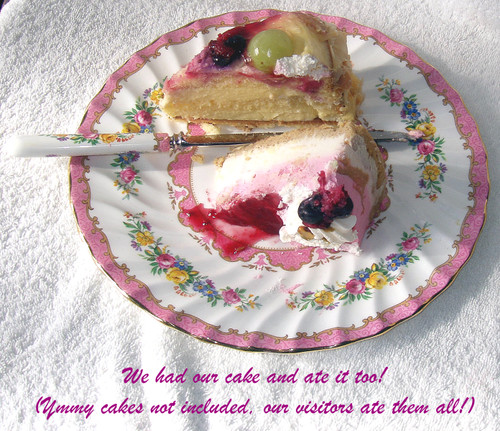HISTORY:
We are in the process of devouring the cakes and then making sure everything is nice and clean again ...
(2 hours later) Done!
Used for the last time just today for a very special afternoon "feast" upon some of the best looking and tasting handmade cakes in Sydney from our local Filipino bakery ... my wife nows says it is time for this cake plate to join another family as ours is overcrowded with beautiful tablewares!
Royal Worcester have been "around" since the 1860's and went to some lengths in making sure the year of manufacture could be identified, using somewhat complicated coding systems on their printed backstamps.
Well before "our time" but we are believe this cake stand originally came from a household of "high standing" and we are pretty sure this pedestal cake plate dates from 1921, based on the Purple printed stamp, the single word ENGLAND and at the base of the backstamp there are Black coding marks. These marks are . . * . . . - we understand that the * indicates the year 1916 and each dot represents one year forward = 1921 in total
Now let's get down to the description of this cake plate ...
ROYAL WORCESTER - Pedestal Cake Plate
Ceramic
Opaque
Base colouring is White
Oval shaped (good for two smaller cakes say 12cm diameter each, a log cake or as we used to do, load it up with slices of various cakes to tempt the guests)
Hand decorated
The design is simple and somewhat geometric, comprising solid continuous patterns around the inner edges (leaf & circles) with the "leaf line" being a deeper Black colour and almost like a daisy chain with a "star shape" connecting the chains, this star is formed using a heavy application of an Aqua Blue paint and in fact is so heavy that it is raised from the plate. Interspersed with these two continuous patterns are six curious patterns. These "look like" three flower stems with either Lime Green or Aqua Blue flower heads. Looking more closely at these, the Black outline of the object has been painted first and then a "splash" of infill colour applied - this infill is not precise, almost like a "dab" than a careful brush stroke.
This is not your traditional soft pastel "flowers" design and leans much more towards the Art Deco style of decoration.
The outer edge/rim has a solid Mauve line. A very similar pattern has also been applied to the body and base of the pedestal, a very difficult area to work in for the artist!
BACKSTAMP DETAILS:
This photograph is taken from the underside of this plate (up inside the pedestal), not an online "copy & paste" as I have seen others offer!

DIMENSIONS:
Top cake plate: 327mm x 253mm
Raised lip around the edges (but still easy to slide a cake knife underneath the cake)
Pedestal: 145mm diameter
The cake plate sits 45mm up off the table surface due to the pedestal
WEIGHT: 1Kg
COSMETIC CONDITION:
This is the part the really matters and believe us, this pedestal cake plate is in such good condition when one considers the age, imagine, this left the works just after WWI and before the rattling of sabres which resulted in WWII
NO cracks
NO chips
NO broken pieces of ceramic
NO observable damage to the decorative artwork
A few light (and I mean light) knife marks in the central area but these are not in any way excessive.
The top surface is shiny, has good glaze integrity (no crazing observed at all!) and is flat except for this one little "dimple" which is definitely from the factory, not user damage.
We do not know how often it was used before we acquired the cake plate in the 1970's but it has seen very little use over it's 100+ year lifetime and has been stored away carefully when not in use.
A splendid pedestal cake plate with some history! Now you can have your cake, eat it and tell the story behind the plate - all at the same time (Uh Uh Uh ... don't speak with your mouth full!)












